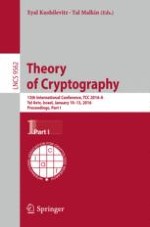2016 | OriginalPaper | Chapter
On the Impossibility of Virtual Black-Box Obfuscation in Idealized Models
Authors : Mohammad Mahmoody, Ameer Mohammed, Soheil Nematihaji
Published in: Theory of Cryptography
Publisher: Springer Berlin Heidelberg
Activate our intelligent search to find suitable subject content or patents.
Select sections of text to find matching patents with Artificial Intelligence. powered by
Select sections of text to find additional relevant content using AI-assisted search. powered by
Abstract
-
There is no general VBB obfuscation in the generic group model of Shoup (Eurocrypt’97) for any abelian group. By applying our techniques to the setting of Pass and Shelat we extend their result to any (even non-commutative) finite ring.
-
There is no general VBB obfuscation in the random trapdoor permutation oracle model. Note that as opposed to the random oracle which is an idealized primitive for symmetric primitives, random trapdoor permutation is an idealized public-key primitive.
